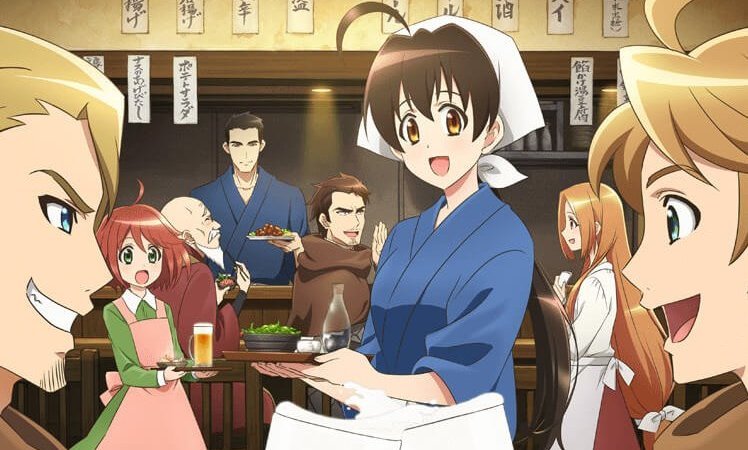Isekai Izakaya is an odd yet delightful little anime series.
To understand it, it's helpful to understand that it's not pure entertainment: It's meant to promote Japanese tourism, particularly independent Japanese restaurants and bars.
The show is set at an izakaya, a small bar that seats about a dozen people and serves traditional Japanese pub food: fried fish, meat skewers, tempura, etc.
However, there's a fantasy twist: the izakaya's front door becomes connected to a D&D-esque Medieval fantasy world. As a result, Medieval people get to experience modern Japanese pub food and alcohol, interacting with the izakaya's (initially) two employees: the unflappable male chef and the cute female waitress.

The show does a good job of humorously and lightly introducing the reader to basic Japanese bar/restaurant culture, like the use of chopsticks for some food, the types of free snacks available, and how you interact with the waitress and chef (since the chef is working a few feet away from you, he may ask you questions about your order directly). It's nice watching an anime series that's truly educational.
The animation is pretty average in quality. Granted, this is a show about bar patrons; they're not getting into situations that require over-the-top action animation. That said, the characters spend most of their time standing or sitting statically, with just lip flaps. The characters also do occasionally wander off-model, though never in an ugly way.
The show's art style feels...pleasantly generic, if that makes sense. It uses the typical bright colors of a standard anime series, and most of the characters feature typical anime character designs, but it doesn't feel lazy. I think because the situation is so unusual, and the staff has to spend so much time drawing specific food, the show would feel more exhausting if the character designs also varied dramatically from what we're used to.
Similarly, the actors portray their characters effectively, though nobody stands out in particular. The waitress does do a great job of having spunk and energy without feeling too aggressive.
As the series progresses and the izakaya gains more patrons, a small amount of plot develops. There's nothing complicated or deep, but it's enough to keep the show from falling into a rut, as most episodes follow a simple pattern: an uncertain new customer arrives, then he or she learns to enjoy the food and becomes a regular patron. There's not much time to develop plot anyway, as the episodes are short: About 10 minutes of anime, then a 5-minute segment that alternates between real-life cooking segments and visits to real-world izakaya.
The staff also take a light touch with the series' presumed need to promote Japanese culture (each episode ends with several Japanese tourism logos). The Medieval characters adore every dish as soon as they taste it, enthusing about each dish's delicate balance of flavors and textures. Thankfully, this isn't taken as over-the-top as, say, Food Wars, where characters experience orgasmic bliss at each bite, but it's just over-the-top enough to be funny.
Interestingly, the show also plays around with the difference between Medieval and modern standards of food. Customers marvel that the restaurant can afford clear glass in their windows and crisp, consistent lager. One discerning foodie nearly loses his mind to discover that they'll serve him as much pepper as he wants. Thankfully, the staff doesn't present Medieval society as muddy peasants drinking dirty water and terrible food; it's more pointing out that modern society does provide huge variety and more consistent quality than earlier times.
Overall, Isekai Izakaya does an excellent job of delivering on its premise: demonstrating Japanese bar/restaurant culture in a novel way, with just enough variety of characters and plot that there's always a reason to watch the next episode. While the animation won't win any awards, it gets the job done, and after the credits on the final episode rolled, I found myself wanting more: both episodes and Japanese food.

![[Atom feed]](/user/themes/geek-archaeology/images/atom-feed.png)
![[RSS feed]](/user/themes/geek-archaeology/images/rss-feed.png)
![[iTunes podcast feed]](/user/themes/geek-archaeology/images/itunes-feed.png)